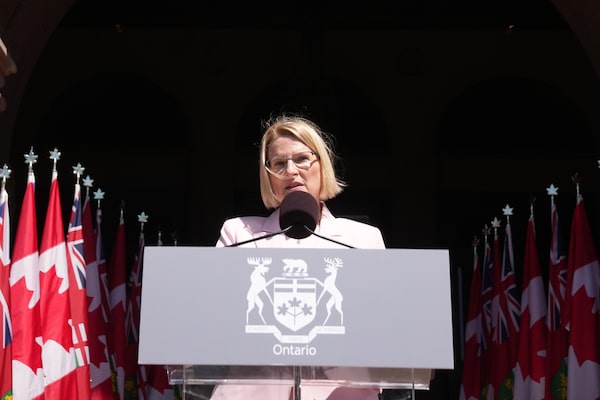
Sylvia Jones, Deputy Premier and Minister of Health takes her oath at the swearing-in ceremony at Queen’s Park in Toronto on June 24, 2022.Nathan Denette/The Canadian Press
Ontario is planning to deal with a crisis plaguing hospitals by boosting the number of surgeries done at existing private-sector clinics, attracting 6,000 more health care workers and legislating new powers to move elderly patients awaiting long-term care into homes that are not of their choosing.
The measures, outlined in an 18-page second phase of Ontario’s “Plan to Stay Open” unveiled on Thursday by Health Minister Sylvia Jones, drew praise from some in the health care system but criticism from opposition politicians and advocates for long-term care residents, who warned that the plan would harm vulnerable seniors.
Much of the plan is short on details. To address surgical backlogs, the government says it will continue increasing the number of publicly funded procedures done both in its pediatric hospitals and in “existing private clinics.” It will also “consider options” for doing more at “independent health facilities.” But the plan does not say what types of surgeries would be included or what private facilities could be expanded.
Ontario has been trying to come up with solutions over the past few months as emergency departments and intensive-care units have faced service disruptions because of staff shortages. Thirteen hospitals have had to temporarily close emergency rooms since the end of June, according to Ontario Health.
In order to free up needed hospital beds, the government introduced legislation on Thursday that would allow hospitals to take steps to move some of the increasing number of elderly patients, who have been deemed by their doctors to no longer need hospital treatment, into a temporary spot in a long-term home that they have not chosen.
The bill says “reasonable efforts” must be made to get the consent of patients or their families, but that the process to find them a long-term care bed could still take place without it. However, the bill also says it would not allow hospital staff to “restrain” a patient or to “physically transfer” one to a long-term care home without consent.
In its plan, the government will also expand a 911 pilot program for paramedics that began in 2020. The expansion would allow paramedics in more regions to respond to palliative care, mental health and addictions calls, without taking patients to an emergency room, to alleviate capacity at hospitals.
On surgeries, Ontario has previously pledged to ramp up the number of procedures, such as eye cataract removals that can be done at private clinics outside hospitals, in order to catch up on the backlog created by COVID-19.
The Ontario Medical Association, which said Thursday it supports the government’s plan, is in favour of moving some procedures to publicly funded stand-alone clinics as a way of reducing the backlog and freeing up hospital space.
Ms. Jones said the government would not be deterred by political opponents who say the government’s measures amount to a creep toward privatization.
“There are some who will fight for the status quo, no matter what. They’re ideologically opposed to change or improvements,” the Health Minister said. “We won’t accept that.”
While Ms. Jones and Premier Doug Ford have used similar language in recent weeks to signal that they’re looking at major changes to health care, both have insisted that all procedures moved into private clinics would remain covered by Ontario’s publicly funded system, the Ontario Health Insurance Plan (OHIP).
At an event at Toronto’s Sunnybrook Hospital alongside Ms. Jones, Long-Term Care Minister Paul Calandra said patients wouldn’t be forced to leave hospital. But he said doctors already engage in conversations with patients who no longer need hospital care about moving to an available long-term bed.
“Ultimately no, we are not going to be forcing anybody out of a hospital,” he said. “But the changes do allow us to continue that conversation.”
If the legislation is passed, the province says, there will be “mandatory guidelines” to ensure patients remain close to family and friends. But those guidelines have not been released. The government says the new policy will free up 250 hospital beds in the first six months, with 1,300 hospital beds freed up this way by March of next year.
An increasing number of these patients waiting in hospital for what is called an alternate level of care (ALC) has strained hospital resources. According to Ontario Health data from May, there are about 5,000 ALC patients in hospitals, a 33-per-cent increase from the year before.
But critics say Ontario’s plan to legislate moving seniors into long-term care facilities they didn’t choose is a major misstep that will cause irreparable harm to many.
“I don’t know if people really appreciate how significant an issue that is, when you ultimately take away peoples’ right to choose where they want to live,” said Samir Sinha, director of geriatrics at Sinai Health and the University Health Network in Toronto and one of the country’s most prominent geriatric-care specialists. “This can go very wrong very quickly.”
Ontario Long-Term Care Association chief executive Donna Duncan said the organization is supportive of the province’s plan to move patients into homes faster, but said more staff are needed to provide care for additional patients.
Rose Zacharias, president of the Ontario Medical Association, said the new proposal isn’t ideal, but could help alleviate the hospital crisis.
“Sometimes, it’s necessary to make difficult decisions for the benefit of the overall health care system,” Dr. Zacharias said.
To address staff shortages that have forced some Ontario hospitals to temporarily shut emergency rooms in recent weeks, the government announced moves to attract more nurses. It will temporarily waive exam and registration fees for internationally trained and retired nurses, saving each person up to $1,500.
In addition, new reports were due Thursday from the province’s colleges that govern its nurses and physicians on how they plan to speed up the accreditation of internationally trained professionals.
Releasing its submission Thursday, College of Nurses of Ontario Council president Naomi Thick said the college has the potential to register 5,970 new internationally trained nurses in “the weeks and months to come.” There are currently 10,273 active international applicants in various stages of the registration process. The college has already set an annual record of 4,728 international registrants in the first seven months of the year.
Dianne Martin, CEO of the Registered Practical Nurses Association of Ontario, said the government should focus on retention strategies to stem the tide of nurses leaving the profession because of unsustainable workloads.
Opposition NDP health critic France Gélinas said the government’s long-term care changes could see patients pressed into moving into older homes that lack air conditioning or had high death rates from COVID-19. She also warned that private clinics can charge extra fees for other services, above the amounts covered by OHIP.
Our Morning Update and Evening Update newsletters are written by Globe editors, giving you a concise summary of the day’s most important headlines. Sign up today.
 Jeff Gray
Jeff Gray Dustin Cook
Dustin Cook Carly Weeks
Carly Weeks